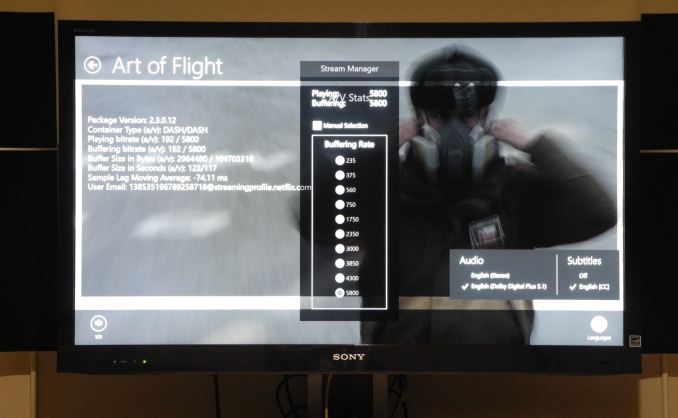The NVIDIA GeForce GTX 750 Ti and GTX 750 Review: Maxwell Makes Its Move
by Ryan Smith & Ganesh T S on February 18, 2014 9:00 AM ESTHTPC Aspects : Network Streaming Performance
Windows 7-based HTPCs need hardware acceleration in both Adobe Flash and Microsoft Silverlight for optimal streaming performance with YouTube and Netflix. The move to Windows 8.1 has made Silverlight unnecessary. The Netflix app on Windows 8.x brings a HTPC's capability on par with dedicated streaming consoles, with support for Super HD (6 Mbps) streams as well as Dolby Digital Plus bitstreaming support. The latest app also renders the video in such a way as to make taking screenshots an exercise in frustration.
As the above photograph shows, the Netflix app can be set to bitstream Dolby Digital Plus to the AV receiver and the 750Ti supports it. The video and audio streams are at 5.8 Mbps and 192 kbps respectively. It is not immediately evident as to whether GPU acceleration is being utilized. However, tracking the GPU / VPU loading and PC power consumption numbers make it obvious that it is not software decode at work in the Netflix app.
Unlike Silverlight, Adobe Flash continues to maintain some relevance right now. YouTube continues to use Adobe Flash to serve FLV (at SD resolutions) and MP4 (at both SD and HD resolutions) streams. YouTube's debug OSD indicates whether hardware acceleration is being used or not.
Similar to our Netflix streaming test, we recorded GPU / VPU loading as well as power consumption at the wall when streaming the 1080p version of the sample YouTube clip. The table below presents the relevant numbers for various configurations and streaming services.
| Streaming Video Performance | ||||||
| Netflix | YouTube | |||||
| GPU/VPU Load | Power | GPU/VPU Load | Power | |||
| NVIDIA GeForce GTX 750 Ti | 11.95/12.65% | 56.44 W | 16.26/15.74% | 55.45 W | ||
| NVIDIA GeForce GT 640 | 5.99/25.80% | 58.89 W | 15.57/25.72% | 58.93 W | ||
| AMD Radeon HD 7750 | 0.72% | 66.79 W | 3.57% | 67.11 W | ||
NVIDIA has been touting Maxwell's low power nature, and it proves to be the best of the three candidates in terms of power efficiency when it comes to GPU support for streaming services.












177 Comments
View All Comments
Harag - Thursday, March 6, 2014 - link
Not true at all. The release of the Titan showed they could unlock FP64 performance on a specific architecture. The Titan Black also has amazing FP64 performance. You may also want to look into their Quadro line.kwrzesien - Tuesday, February 18, 2014 - link
Cards are available on Newegg! Check out this EVGA Superclocked (1268MHz) with a dual-fan ACX cooler and 6-pin PCIe power connector: http://www.newegg.com/Product/Product.aspx?Item=N8...Frenetic Pony - Tuesday, February 18, 2014 - link
Maxwell is designed for mobile gaming, in which case who cares? Broadwell looks to improve performance per watt at least as much as Maxwell if Intel's initial hints of 30% power improvement for 14nm and 40% improvement for gpu power efficiency pan out. And they were already damned good.But Maxwell isn't designed for high end, in which case GCN 1.1 and AMD are already beating them for price for performance. Congrats Nvidia, you're second place in both categories if this card is anything to go by. I hope to hell your Titan 2 or whatever kicks more ass than this card.
varad - Wednesday, February 19, 2014 - link
@FreneticPony, statements like "Maxwell is designed for mobile gaming" and "But Maxwell isn't designed for high end" tell us you know precious little. Maxwell is an architecture that will span across all of Nvidia's products [Tegra, GeForce, Quadro and Tesla].Frenetic Pony - Thursday, February 20, 2014 - link
Err... they intend to produce as such yes. But it's obvious the architecture itself is targeted squarely at mobile. Power constraints don't actually get in the way as much as other constraints do on the high end. Who really cares if it's 150+ tdp if it's gaming? You get constrained by memory latency and other things no matter how high you can clock it up.This appears to be Nvidia's version of Haswell, concentrated solely on improving performance per watt rather than performance at all. Which is bad timing as Intel is doing the same, but integrates it's GPUs right onto the chip, making them cheaper and smaller than any dedicated card for a laptop is going to be. Meanwhile AMD is crushing Nvidia in both compute and high end gaming performance on the desktop for performance per $.
True, this will help mitigate electricity cost. for compute based work. But as others pointed out not by much. Meaning Nvidia stuck itself with the wrong focus at the wrong time. Maybe it will help with their Tegra SOCs, if they're lucky they'll get back into the game, as Qualcomm soundly crushed the Tegra 4 for third party ARM Socs over the last year.
So, no, it's designed for high end. Doesn't mean they're not going to do it anyway.
Frenetic Pony - Thursday, February 20, 2014 - link
I.E. it really doesn't matter how well they did at what they're doing. Because Intel has done just as well and has built in advantages for its market, what their doing doesn't help that much against AMD in the high end market, and this leaves their only chance for financial success with it being next years Tegra SOCs.ninjaquick - Thursday, February 20, 2014 - link
Plus, AMD is easily capable of taking Nvidia on at the low end with better hardware across the board, more integrated designs, etc.willis936 - Thursday, February 20, 2014 - link
Pro tip: you're always TDP limited. Increasing performance per watt IS increasing performance.Harag - Thursday, March 6, 2014 - link
Broad statements like "AMD is crushing Nvidia..." only proved @Varad correct. you know precious little.HisDivineOrder - Wednesday, February 19, 2014 - link
nVidia fits a lot more performance in a little more space at a lot less power and you think they're doing poorly? This is on the same node.Imagine what they'll pack into a smaller node.
Their focus is probably the right one, given the fact they want to migrate these cores into Tegra.